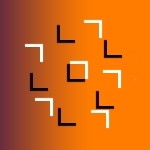
ISSN 2364-3641
Publications:
direct access:
vpl-reports.de
Open Access
| home | evaluation | archive | vpl-goettingen.de | impressum |
|
VPL-reports, 1, 1-38
For the quantitative analysis of luminance-defined salience, blob arrays on different backgrounds
(5.5-68 cd/m2) were adjusted until they appeared equally conspicuous. Matches of blobs at same
luminance polarities (all dark or all bright) closely followed the constant-ratio rule; that is, blobs appeared
equally salient when their luminance ratio to background was constant (Exp. 1-3). Gradual deviations
from this rule reflected salience contributions from brightness perception and assimilation effects (Exp. 4
and 5). Bright targets, however, were special in that equal-salience matches could instead follow the
constant-addition rule or intermediate settings when the blobs to be adjusted were the brightest items in
the display. Matches of patterns with different luminance polarities (dark versus bright blobs) showed
variable characteristics. On the same backgrounds, they closely followed the Weber contrast (equal
increments and decrements) for small and medium luminance differences and saturated at larger blob
contrast (Exp. 6). On different backgrounds, however, performance was better predicted by Stevens'
brightness law, i.e. by constant differences of blobs and backgrounds on a power function (exponent
x<0.5) of luminance (Exp. 7). The findings were partly confirmed in a final experiment in which pairs of
patterns with predicted equal salience settings were reviewed for similar conspicuity (Exp. 8). Predictions
were based on various algorithms and also made over a much larger luminance range (0.1-220 cd/m2).
While constant-ratio predictions were generally accepted for dark blobs, those for bright blobs were often
rejected and better ratings instead obtained from constant differences in the power of luminance. Crosspolarity
matches of dark and bright blobs were fairly tolerant at medium contrast and ratings little
distinctive between algorithms. But when the luminance range was increased, best equal-salience ratings
were again obtained for constant differences on Stevens' power function.
|
Download pdf ppt of figures Comments: |
©